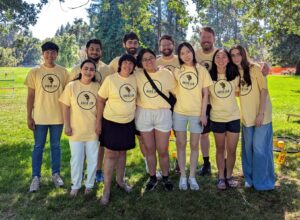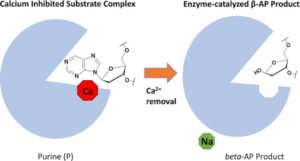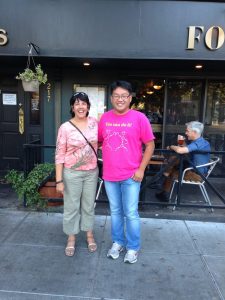Welcome to the David Lab Website!
The David Lab at UC Davis utilizes numerous tools of chemical biology to explore the complex mechanistic details of DNA repair enzymes. DNA repair proteins such as MutY and NEIL, among the targets of research of the David Lab, help catalyze necessary repair of oxidative DNA damage, and are critical to maintaining genomic integrity in organisms living in the oxygen-rich environment of Earth. The David Lab is headed by Dr. Sheila S. David, who has led at the forefront of DNA repair research for the last 30 years. The David Lab continues to push forward the world’s current understanding of DNA repair enzymes by leveraging our unique expertise in DNA repair enzymology while venturing into new areas and collaborating with scientists around the world.

Featured Article:
FSHing for DNA Damage: Key Features of MutY Detection of 8-Oxoguanine: Adenine Mismatches
Accounts of Chemical Research
“We defined MutY structure−activity relationship (SAR) studies using synthetic analogs of OG and A in cellular and in vitro assays. Our studies revealed the 2-amino group of OG as the key distinguishing feature of OG:A mismatches.”
Click here to read more!

Authors:
Chandrima Majumdar, Merve Demir, Steven R. Merrill, Mohammad Hashemian, and Sheila S. David*
Cellular Repair of Synthetic Analogs of Oxidative DNA Damage Reveals a Key Structure–Activity Relationship of the Cancer-Associated MUTYH DNA Repair Glycosylase
ACS
“We reveal key structural features of OG required for efficient repair by human MUTYH using structure–activity relationships (SAR). We developed a GFP-based plasmid reporter assay to define SAR with synthetically generated OG analogs in human cell lines.”

Structural snapshots of base excision by the cancer-associated variant MutY N146S reveal a retaining mechanism
Nucleic Acids Research
“We captured structural snapshots of N146S Geobacillus stearothermophilus MutY bound to DNA containing a substrate, a transition state analog and enzyme-catalyzed abasic site products to provide insight into the base excision mechanism of MutY and the role of Asn.”
Click on the link to read more!
https://doi.org/10.1093/nar/gkac1246

Authors:
Nucleic Acids Res. Jan. 12 2023, gkac1246.
Recent Articles:
Featured Photos:

ACS Chemical Biology LiveSlides Presentation:
Structure–Activity Relationships Reveal Key Features of 8-Oxoguanine: A Mismatch Detection by the MutY Glycosylase
Listen in while Chandrima Majumdar explains this recent work from the David Lab, which was selected as an ACS Editor’s Choice article.
For the latest David Lab updates, check out the News section.
Click on Research for an overview of The David Lab’s research.
A thorough list of publications is available in the Publications section.
Graduate Student Spotlight
In our second installment of David Lab Graduate Student Spotlight, you will meet Elizabeth Lotsof, a Graduate Student in Sheila David’s lab at UC Davis in the Department of Chemistry seeking to earn her Ph.D. in Chemistry. Liz focuses on DNA repair enzyme NEIL in her research. Watch now to catch her commentary on graduate school and the David Lab!
Introducing the David Lab Graduate Student Spotlight! Check out our conversation with Nicole as she discusses her journey as a Ph.D. student working in the David Lab.
Undergraduate Student Spotlight
Meet UC Davis Undergraduate Researcher Madeline Bright in our lab’s new Undergraduate Student Spotlight Video!
David Lab FYI Video
How to efficiently pour column fractions: Run a column <60 min.
Doing this will greatly increase your already-existing love of columns. And your productivity.
Get the most out of your flash column. It’s not called slow column chromatography.
Use this information at your own risk. This video is intended for graduate / professional level researchers. Be sure to follow your lab’s safety protocols.
Video by Robert Van Ostrand.
David Lab YouTube Trailer – June 2020
Subscribe to our YouTube Channel!
A tribute to Jongchan Yeo, you are dearly missed.


Jongchan Yeo was a cherished member of the lab. He received his PhD in Chemistry in 2014 and went on to attend UC Berkeley for his post-doctoral training. He is pictured with Sheila David in his bright pink shirt that he wore while at the library for his students to find him (left) and presenting his research poster at EMGS (right). Thank you for all of your hard work.
His work from our lab has been published in Biochemistry.

David Lab Members

Follow us on Instagram!
Keywords: #DavidLab #TheDavidLab #UCDavis #DNA #DNARepair #Muty #Mutyh #8OG #enzymes #ModifiedOligonucleotides #ModifiedNucleosides #OrganicSynthesis #Synthesis #BaseExcisionRepair #BER #NEIL #ChemicalBiology #Chemistry #SheilaDavid #UCDavisChemistry #glycosylase #DNARepairUCDavis